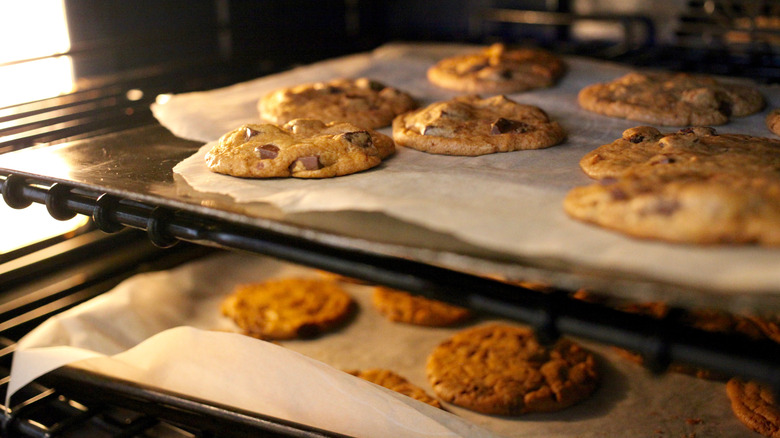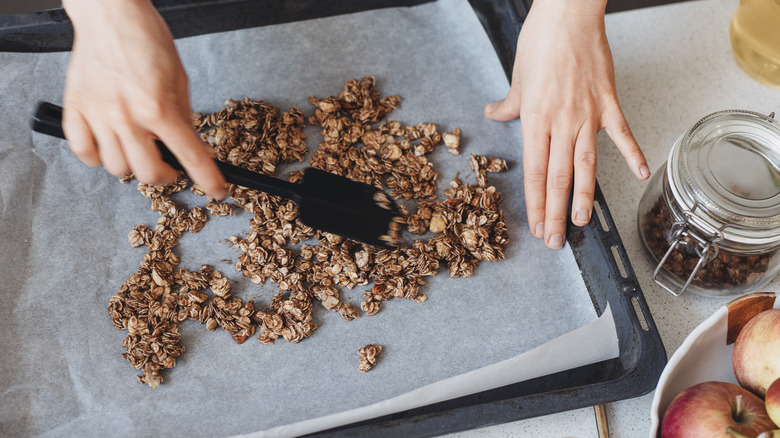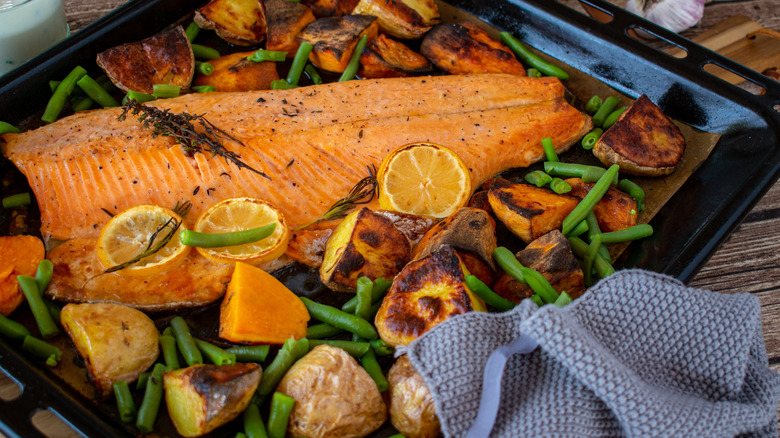Actually, Sheet Pans And Baking Sheets Are Not The Same Thing
There is probably a stack of pans tucked in your kitchen cabinet right now. They may vary slightly in size or shape. Some may be nonstick, others are worn through so many years that their original surface texture is unknown. Called baking sheets, or sheet pans, they sit ready to be used interchangeably to cook a variety of dishes. From cookies to roasted vegetables, it seems like that collection of flat, rectangular pans can do just about anything. But did you know that your collection might include baking sheets and sheet pans, which are meant to be used for separate and unique purposes?
The difference between a baking sheet and a sheet pan is more than just colloquial, and knowing the difference might just be key in executing your next recipe. While both pans are rectangular, flat, and usually made of aluminum, sheet pans feature a raised rim usually about an inch in height while baking sheets have a lower, rolled rim. Understanding this key difference is essential to utilizing these unsung kitchen tools to their full potential.
It's all in the raised rim
You may be wondering what distinguishable difference there could possibly be between a baking sheet and a sheet pan. After all, they're both flat and rectangular pans, usually made of aluminum. However, when examined, you will find that they are actually quite different. Perhaps the most notable difference between the two is the rim. Sheet pans feature a raised rim about one inch in height around their borders. Meanwhile, baking sheets feature rolled edges that are not as raised as a sheet pan's rim. This raised rim helps in making jelly rolls and roasting vegetables. Sheet pans also come in several sizes, such as half and quarter-sheet pans, which can be helpful when using smaller ovens.
The raised rim of a sheet pan makes it a perfect cooking surface for roasted vegetables, pan pizzas, and meatloaf, among other dishes as it allows for dishes to be spread out evenly over a flat surface while also preventing the overflow of cooking oils or other, messier elements which are best kept from the surface of your oven. Meanwhile, the baking sheets' lower rim design creates better airflow for baking. However, cooking dishes such as roast vegetables on a baking dish can be a rolling hazard on a baking sheet, because of its lower rim. For a completely rimless option for cookie baking, try a cookie sheet which, unlike a baking sheet, features a completely flat surface and only one raised edge for gripping. The completely flat surface allows for maximum airflow.
Making the most of your pan collection
When it comes to baking sheets versus sheet pans, it's clear that both can be handy tools in the kitchen. Baking sheets are an essential tool for anyone hoping to yield consistent results in their cookie recipes. However, their use is more specialized. Sheet pans on the other hand are more versatile. You'll find yourself grabbing a standard sheet pan to heat frozen french fries, broil potatoes, and roast vegetables, to name just a few. And in conjunction with other tools, you'll get even more use out of this workhorse kitchen tool. Layered with a wire cooling rack, it provides a surface to collect dripping oil while making crispy and evenly cooked bacon or roasted chicken, avoiding a soggy, flattened bottom.
A sheet pan is also perfect for, well, sheet pan dinners. A sheet pan dinner is just that: a full meal cooked on the surface of a sheet pan. There are countless sheet pan dinner recipes, most of which consist of a protein and vegetables or starches cooked together on the same pan, at one temperature and time. Single-sheet meals such as sheet-pan Italian sausage dinner or sheet-pan quesadillas can make the chore of weekday dinners a breeze. Regardless of how or when you use your sheet pan, however, it's important to understand the purposes and limitations of even the most default kitchen tools.


